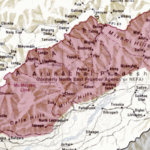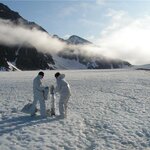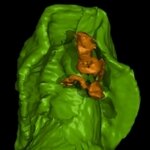Ecology & Zoology
Growing up in the Midwest of the United States, and taking several trips over my lifetime to an Atlantic or Gulf of Mexico beach, I recall the vague consideration of the floating jellyfish. Maybe it's hard to see them, but they will hurt a lot of you touch one of their venomous cells. And, there were certainly few horror stories that need not be transcribed here. Watching the Pixar classic "Finding Nemo" provides a daunting realization--albeit digitally conceived--of the beauty and the devastation of the jellyfish bloom.
Apparently, the jellyfish population in the Mediterranean Sea…

I probably first heard of the McMahon Line in 1962, when there was a brief war between China and India for control of the Himalayan border between them.
My chief memory of this is a Giles cartoon of the time, showing a policeman investigating a dispute between two neighbouring restaurants, one Chinese, one Indian.
Now Chinese soldiers are again crossing the McMahon line, but this time not as a military venture, but in search of a prized Chinese medicine. This is known in the West as the Caterpillar Fungus, but in Chinese as "Winter worm, summer grass" (in Tibetan it is Summer…

One way to understand how life similar to that on Earth could exist on other planets is to travel to one of the coldest places on Earth and find the planet's coolest creatures.
Professor Liane Benning from the University of Leeds and Dr. Dominique Tobler from the University of Glasgow are traveling to Ny-Ålesund on the island of Svalbard to investigate how the snow and ice there was first colonized by extremophiles, which frequently refers to prokaryotes but are any organisms that thrive in harsh conditions.
The team will spend two weeks on Svalbard from August 6th to the 20th as part of the…

Remember the octopus that stole a diver's camera and filmed itself swimming away? Ha ha ha, very nice--but it's only a few minutes of footage of only one octopus. Can you top that, Humboldt squid? Why yes, I think you can!
Well okay, scientists helped out a little bit. My PhD advisor Gilly figured out how to attach National Geographic's Crittercam (which has been stuck on whales and turtles, but never before, I believe, on an invertebrate) to a Humboldt squid. It was a tricky endeavor to affix a camera to a smooth, slippery, bendy surface. Squids won't wear collars, and they have no hard…

A blob-like creature that lived in the ocean approximately 425 million years ago was revealed in research published today.
The scientists developed a detailed 3D model of the only known fossilized specimen in the world of a creature called Drakozoon. The specimen was found by one of the team approximately 6 years ago in the Herefordshire Lagerstätte, one of England's richest deposits of soft-bodied fossils. Drakozoon lived in the ocean during the Silurian Period, 444 to 416 million years ago, and today's model hints at how it lived.
The research reveals that Drakozoon was a cone-…

A new corticosteroid hormone in the sea lamprey, an eel-like fish and one of the earliest vertebrates dating back 500 million years, may shed light on the evolution of steroid hormones.
Principal investigator and lead author David Close of the University of British Columbia's Department of Zoology andcolleagues at Michigan State University identified a corticosteroid hormone called 11-deoxycortisol in the sea lamprey that plays dual roles in balancing ions and regulating stresses, similar to aldosterone and cortisol in humans.
Native to the Pacific Coast of North America and Asia,…

Tadarida brasiliensis mexicana, or the Mexican Free-Tailed Bat to you and I, is a superlative species. Not only do they form the largest congregations of mammals in the world, but less well known is that these little guys are also the fastest bats on the planet. This is a species that's close to my heart. Just a short drive from my home in Davis, California underneath a freeway bridge that takes cars over the Vic Fazio Yolo Wildlife area (the largest wetland restoration project west of Florida) to Sacramento, roost a colony of an estimated…

The Cornell Lab of Ornithology--a premier citizen science research and support organization--is launching an exciting new program in the Fall of 2010. The Lab focuses most of its energy on aggregating and analyzing the efforts of thousands of volunteer citizen scientists to better understand the population and behavior of birds. Now, they are interested to better understand the habitats of birds, and not just the wild birds perched on remote mountain tops, but those right in your very own back yard.
The upcoming launch of YardMap.org will help researchers better understand the relationship…
Having just recently returned from our first Walt Disney World family vacation, we were thoroughly impressed with the incredible organization and overall pure dedication of all the “cast members” to making sure that you have a “magical experience.” It is also great to know that the company has an equally pure dedication to supporting regional and worldwide environmental citizen science opportunities.
The Disney Worldwide Conservation Fund has recently focused on ten Florida-based efforts from their 2010 round of $1.5 million in global funding initiatives. The funding works…

Part of the enjoyment in birding includes directly experiencing nature, taking your time, breathing, listening, watching each rustle in the trees, and listening some more. Part of the limitations, however, might be that you only can experience your back yard, you don’t have enough financial resources to travel around the world chasing exotic species, or you just don’t have enough time to escape the real world long enough to enjoy the birds.
From an environmental scientists’ perspective, a significant limitation to monitoring the long-term bird activities and population in an…